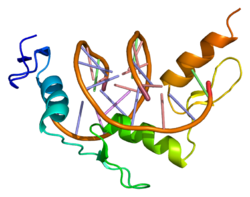Early growth response protein 2 (EGR2), also known as Krox20, is a transcription factor encoded by the EGR2 gene in humans. It is highly expressed in migrating neural crest cells and later in neural crest-derived cells of the cranial ganglia. [5] [6] [7] Expression of EGR2 is restricted to early hindbrain development, [6] [8] and the gene is evolutionarily conserved among vertebrates, including humans, mice, chicks, and zebrafish. [9] The conservation of its amino acid sequence and embryonic expression pattern underscores its essential role in hindbrain segmentation and neural differentiation. [7] [10] [11] [12]














